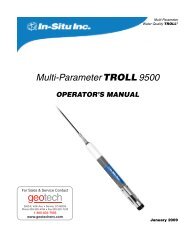TEST INSTRUCTIONS - Geotech Environmental Equipment
TEST INSTRUCTIONS - Geotech Environmental Equipment
TEST INSTRUCTIONS - Geotech Environmental Equipment
You also want an ePaper? Increase the reach of your titles
YUMPU automatically turns print PDFs into web optimized ePapers that Google loves.
CHLORINE, TOTAL - UDV<br />
DPD METHOD–UNIT DOSE VIALS CODE 4312-H<br />
QUANTITY CONTENTS CODE<br />
1 *Total Chlorine Unit Dose Vials, 10 pouches *4312-H<br />
*WARNING: Reagents marked with an * are considered hazardous substances. To<br />
view or print a Material Safety Data Sheet (MSDS) for these reagents see MSDS CD<br />
or our web site. To obtain a printed copy, contact us by e-mail, phone or fax.<br />
<strong>Equipment</strong> needed but not supplied:<br />
STANDARD ACCESSORY PACKAGE CODE 1961<br />
1 Package of 3 Vials (empty) 0156<br />
1 Syringe, 6 mL, plastic 1184<br />
1 Foil Storage Bag 9467<br />
Or:<br />
ADVANCED ACCESSORY PACKAGE CODE 1962<br />
1 Pipettor 30528<br />
1 Pipet Tip (0-5 mL) 30695<br />
1 Cuvette Rack 31695<br />
1 Package of 3 Vials (empty) 0156<br />
1 Foil Storage Bag 9467<br />
All water for cities and communities must be sanitized; even waters that come<br />
from clean sources, protected watersheds, reservoirs, and deep wells, are<br />
commonly sanitized to assure safety. Chlorine is the most commonly used<br />
sanitizer for several reasons: it is effective against a wide range of<br />
microorganisms, the cost is low, and the methods of applying it have been well<br />
developed. If an adequate concentration of chlorine is present in the water for<br />
a few minutes, disease producing bacteria will be destroyed. A number of<br />
conditions affect the sanitizing action of chlorine. In municipal systems these<br />
can be controlled so that if chlorine is detectable, it can be assumed that<br />
bacteria have been killed. The factors that influence the rate of sanitization are<br />
temperature, pH, presence of other materials that react with chlorine, time,<br />
and the concentrations of the various chlorine combinations that are formed in<br />
the water with ammonia and other substances that react with chlorine.<br />
The fact that chlorine can be easily detected and measured makes chlorine a<br />
favorite water sanitizer of those concerned with the public safety of water<br />
supplies. Chlorine concentrations in the range of 0.1 to 0.4 parts per million<br />
are usually maintained in municipal supplies.<br />
Smart2 <strong>TEST</strong> PROCEDURES 2.04 Chlorine, Total - UDV 1/3

















